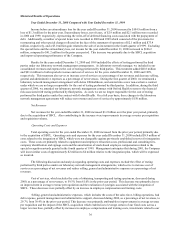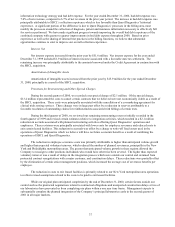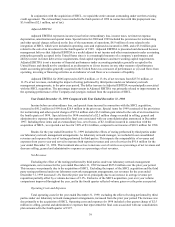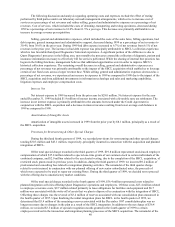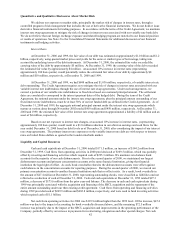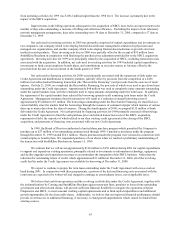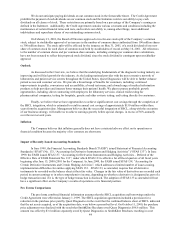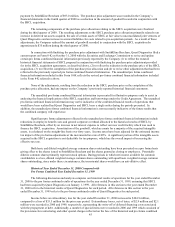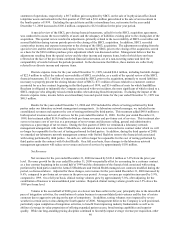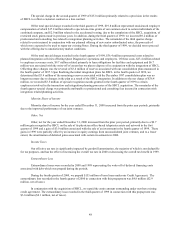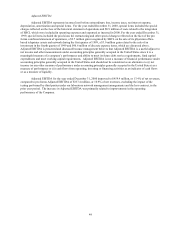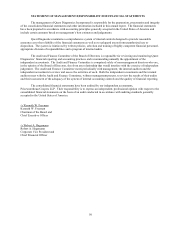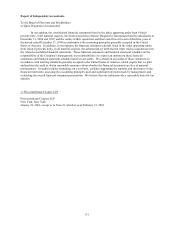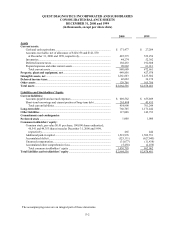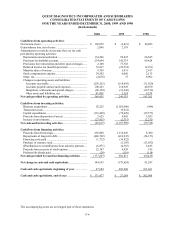Quest Diagnostics 2000 Annual Report Download - page 64
Download and view the complete annual report
Please find page 64 of the 2000 Quest Diagnostics annual report below. You can navigate through the pages in the report by either clicking on the pages listed below, or by using the keyword search tool below to find specific information within the annual report.44
We do not anticipate paying dividends on our common stock in the foreseeable future. The Credit Agreement
prohibits the payment of cash dividends on our common stock and the Indenture restricts our ability to pay cash
dividends on all classes of stock. These restrictions are primarily based on a percentage of the Company’s earnings as
defined in the Indenture. Additionally, the Credit Agreement contains various covenants and conditions including the
maintenance of certain financial ratios and tests, and restricts our ability to, among other things, incur additional
indebtedness and repurchase shares of our outstanding common stock.
On February 21, 2001, the Board of Directors approved a two-for-one stock split of the Company’s common
stock, subject to stockholder approval of an increase in the number of common shares authorized from 100 million shares
to 300 million shares. The stock split will be effected by the issuance on May 31, 2001, of a stock dividend of one new
share of common stock for each share of common stock held by stockholders of record on May 16, 2001. All references
to the number of common shares and per common share amounts, including earnings per common share calculations,
have not been restated to reflect this proposed stock dividend, since the stock dividend is contingent upon stockholder
approval.
Outlook
As discussed in the Overview, we believe that the underlying fundamentals of the diagnostic testing industry are
improving and will fuel growth for the industry. As the leading national provider with the most extensive network of
laboratories and patient service centers throughout the United States, Quest Diagnostics will be able to further enhance
patient access and customer service. We provide a broad range of benefits for customers, including: continued
improvements in quality; convenience and accessibility; a broad test menu; and a broad range of medical information
products to help providers and insurers better manage their patients' health. We plan to pursue profitable growth
opportunities, including: direct contracting with employers for laboratory services; clinical trials testing for
pharmaceutical companies; testing for hospitals; genetic and other esoteric testing; and testing directly for consumers.
Finally, we believe that we have opportunities to achieve significant net cost savings through the completion of
the SBCL integration, which is estimated to result in annual cost savings of approximately $150 million within three
years from the acquisition date. Management believes that the successful integration of SBCL, along with the execution
of our business strategy, will enable us to achieve earnings growth, before special charges, in excess of 30% annually
over the next several years.
Inflation
The Company believes that inflation generally does not have a material adverse effect on its operations or
financial condition because the majority of its contracts are short term.
Impact of Recently Issued Accounting Standards
In June 1998, the Financial Accounting Standards Board (“FASB”) issued Statement of Financial Accounting
Standards (“SFAS”) No. 133, “Accounting for Derivative Instruments and Hedging Activities” (“SFAS 133”). In June
1999, the FASB issued SFAS 137, “Accounting for Derivative Instruments and Hedging Activities – Deferral of the
Effective Date of FASB Statement No. 133”, under which SFAS 133 is effective for all fiscal quarters of all fiscal years
beginning after June 15, 2000 (2001 for the Company). In June 2000, the FASB issued SFAS 138, “Accounting for
Certain Derivative Instruments and Certain Hedging Activities”, which addresses a limited number of issues causing
implementation difficulties for entities applying SFAS 133. SFAS 133, as amended, requires that all derivative
instruments be recorded on the balance sheet at their fair value. Changes in the fair value of derivatives are recorded each
period in current earnings or in other comprehensive income, depending on whether a derivative is designated as part of a
hedge transaction and, if it is, the type of hedge transaction is disclosed. The adoption of SFAS 133 as amended will not
have a significant effect on the Company’s results of operations or its financial position.
Pro Forma Comparisons
The pro forma combined financial information assumes that the SBCL acquisition and borrowings under the
Credit Agreement were effected on January 1, 1999. The SBCL acquisition agreements included a provision for a
reduction in the purchase price paid by Quest Diagnostics in the event that the combined balance sheet of SBCL indicated
that the net assets acquired, as of the acquisition date, were below a prescribed level. On October 11, 2000, the purchase
price adjustment was finalized with the result that SmithKline Beecham owed Quest Diagnostics $98.6 million. This
amount was offset by $3.6 million separately owed by Quest Diagnostics to SmithKline Beecham, resulting in a net




